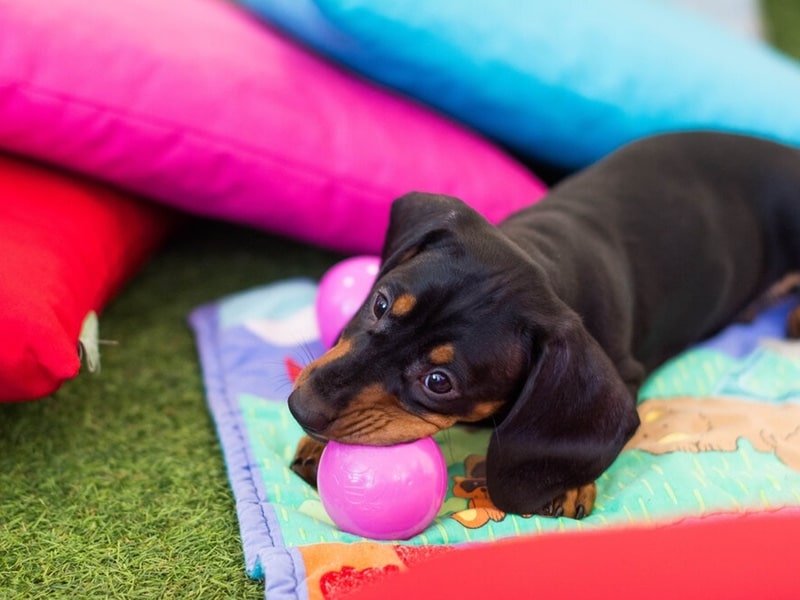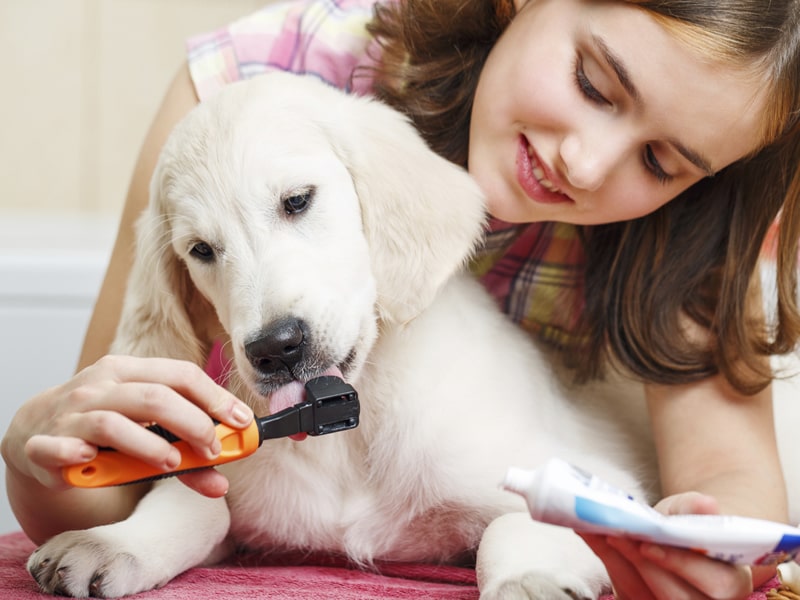
Usually when an owner is waiting for a new puppy to come home they are worried about things like whether he will like his crib, whether he will enjoy his food, whether he will like the toys we provide and of course, adapting to the new home, probably the last worry he will have is teething.
Teething stages aren’t the only important things about puppies, have you checked to see if your puppy is up to date with his vaccinations?
WHAT IS PUPPY TEETHING?
Just as with us humans, when dogs are born they have absolutely no teeth. It is from the first few weeks of life between the second and third week that the first baby or temporary teeth begin to appear, the first to show are the incisors, followed by the premolars, molars and canines.
Once your puppy has all his baby teeth, they will begin to fall out and be replaced by bigger, stronger teeth, which will be the permanent teeth. This process of naturally replacing the deciduous (temporary or baby) teeth with permanent or permanent teeth is called the puppy teething process.
HOW LONG DOES TEETHING LAST IN PUPPIES?
This entire process occurs over the course of a few months, but can vary from dog to dog. Most dogs will begin teething at 8 weeks of age and by 6 months of age will have completed the process and obtained all of their adult teeth. So we can answer that the teething process takes about 4 months.
STAGES OF PUPPY TEETHING
Dogs like us humans have different stages of teething, however, they have many more. The determination of a dog’s age can be established, approximately, by looking at the development of its teeth. Next, let’s look at the five stages of teething that puppies go through and that we as owners should be aware of. It should be noted that these stages can vary individually, as is the case with toy puppies where this process can be delayed
- STAGE 1: 2-4 WEEKS:
When the puppies are born, they have no visible teeth. Their teeth remain hidden in their gums until about three weeks of age when they begin to appear, although sometimes these teeth can begin as early as two weeks.
The first ones to appear approximately on the 15th are the upper fangs, on the 17th the ends of the upper jaw appear and in the following days the rest of the upper milk teeth in the front part while between the 20th and 21st the lower fangs erupt and successively the rest of the lower ones.
It is important to note that this first set of teeth is made up of small and not very sharp teeth, which means that any of the teeth that appear during the first few weeks will not hurt the mother when the puppies are nursing.
- STAGE 2: 5-6 WEEKS
Between the fifth and sixth week of life, a puppy will begin to develop its canines and premolars. The canines are the long, sharp teeth that will help them bite and tear food, and the premolars are used for tearing and cutting to help them chew.
Once this stage is over, puppies will have 28 milk teeth, or deciduous teeth (12 incisors, 4 canines, 12 premolars). This information can help us to know how old a puppy is by its teeth. From this moment on, they will begin to be weaned from their mother, as nursing will be much more difficult with the sharper teeth coming down from the gums.

- STAGE 3: 8 WEEKS-3 MONTHS
When a puppy comes into our hands at eight weeks of age, it must have all its baby teeth. This is also a very positive thing, because it means that we can already introduce soft foods into his food. But you’re probably wondering when puppies lose their baby teeth? Right away, they go straight to the next stage of teething, which is when they start losing their teeth. This will happen gradually over the weeks.
- STAGE 4: 3-6 MONTHS
Between 3 and 6 months of age you will notice that your puppy does not have a strong grip when he bites. That is, they don’t have enough strength in their jaws to play tug-of-war with a rope-like toy, and this is because the roots are not absorbed by the gums until this stage. Providing a puppy toy that encourages chewing means his bite will grow stronger and as he chews and bites harder, the baby teeth will continue to fall out until he reaches six months.
- STAGE 5: 6-8 MONTHS
By six months of age, your dog should have lost all his puppy teeth and have all his adult teeth. Some puppies may need until they are seven or eight months old to do this, as the growth period may be different depending on the dog and his genes. By eight months, your dog should have all 42 adult teeth (12 incisors, 4 canines, 16 premolars and 10 molars) which are relatively the same size.
PUPPY TEETHING TOYS: HELP SOOTHE YOUR DOG’S GUMS
Puppy teething can be quite painful for your puppy! In the teething stage, they feel the need to chew, soothing the gums and growing teeth. That’s why many dogs chew on everything they can see.
WHY DO YOU NEED PUPPY CHEWING TOYS?
The first reason why you should buy puppy chew toys seems pretty clear: it’s important that your puppy has his own toys to satisfy his need to chew, puppies love to have fun, and if they don’t have their own toys you can take any object you have within reach and look at it as a chew toy, whether it’s our furniture or personal belongings, don’t get smashed by a teething puppy.
So, we can conclude that it is essential to help soothe your puppy’s gums, as teeth are very important and apart from brushing, you should provide him with toys that will help him with his dental health, also develop his intelligence and skills, as well as release energy, avoid stress and anxiety.
DO I NEED TO BRUSH MY PUPPY’S BABY TEETH?
A routine of dental hygiene from puppies is fundamental to avoid that our dog suffers in the future from periodontal diseases, and if it is a toy breed with more reason, since, these dog breeds have predisposition to this disease. But what about the milk teeth? Do they need to be brushed too? It is true, that our puppy’s milk teeth will be renewed by the permanent ones but we all know that we must brush our adult dog’s teeth regularly.
On the one hand, with brushing from puppies what we want is to create a habit, this way, as adults, they will accept more easily the routines of dental and oral hygiene. On the other hand, healthy teeth mean healthy gums. No one wants their puppy to have infected gums when they’re already dealing with painful gums.
The best option, of course, for maintaining your puppy’s oral health is to use a specially developed toothbrush and toothpaste such as Orozyme Toothpaste with egg yolk extract from hyperimmunised hens versus Porphyromona bacteria (the main plaque bacteria). It incorporates enzymes and a mucoadhesive component that helps the product remain in the gums for a long time.

